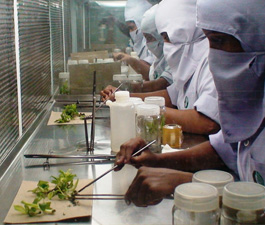Plant Tissue Testing
Plant tissue analysis is a strategic monitoring tool which can compliment soil testing. Plant tissue testing allows farmers to fine-tune nutritional programs by testing exactly what is in the plant.
Plant tissue testing is particularly useful for determining the timing of nutrient applications, ensuring the right balance of different nutrients, and for confirming possible trace-element deficiencies before they affect production.
Correct sampling techniques are critical for plant tissue tests to be effective. Sampling advice is available in plant tissue testing kits or from your local Plantations International agronomist.
Plant tissue material is dried and analyzed for major chemical elements (eg nitrogen) or trace elements (eg zinc). Actual levels are then compared with ideal levels in the particular crop at the same stage of growth, developed following decades of research. Results are interpreted and recommendations are made.

In agriculture, a soil test is the analysis of a soil sample to determine nutrient and contaminated content, composition, and other characteristics such as the acidity or pH level. A soil test can determine fertility, or the expected growth potential of the soil which indicates nutrient deficiencies, potential toxicities from excessive fertility and inhibitions from the presence of non-essential trace minerals. The test is used to mimic the function of roots to assimilate minerals. The expected rate of growth is modeled by the Law of the Maximum. Plantations International recommends that a soil test contains 10-20 sample points for every 40 acres of field. As soil nutrients vary with depth and soil components change with time, the depth and timing of a sample may also affect results.
Composite sampling can be performed by combining soil from several locations prior to analysis. This is a common procedure, but should be used judiciously to avoid skewing results. This procedure must be done so that government sampling requirements are met. A reference map should be created to record the location and quantity of field samples in order to properly interpret test results.
Our Laboratories tests o for plant nutrients in three categories:
-
-
- Major nutrients: nitrogen (N), phosphorus (P), and potassium (K)
- Secondary nutrients: sulfur, calcium, magnesium
- Minor nutrients: iron, manganese, copper, zinc, boron, molybdenum, chlorine.
- Soil testing is used to facilitate fertilizer composition and dosage selection for land employed in both agricultural and horticultural industries.
-
To find out more about the Plantations International Plant Tissue Testing services and kits and to receive a free initial consultation, please call us today on +852 5808 3775 or Click Here to contact your nearest Plantations International representative.
